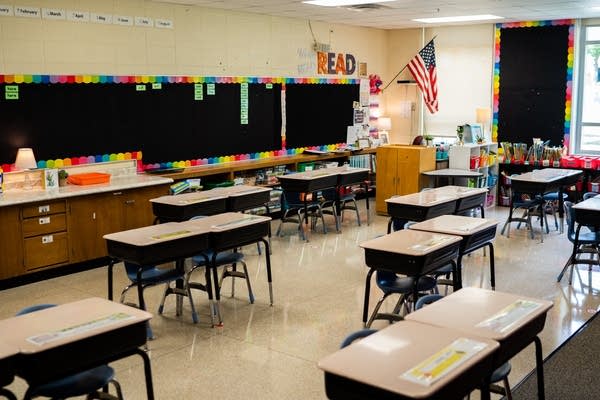MN state test scores reveal deep impact to child learning during pandemic

Go Deeper.
Create an account or log in to save stories.
Like this?
Thanks for liking this story! We have added it to a list of your favorite stories.
The number of Minnesota students meeting grade-level standards in math, science and reading is down significantly compared to the last time students took tests in 2019.
Only 53 percent of students met grade-level reading standards. That’s nearly 7 percentage points down from 2019. But math and science saw even steeper drops. Only 44 percent of Minnesota students met or exceeded math standards. And only 43 percent met or exceeded science standards. That is 11 and 8 percentage points lower than before the pandemic.
The shifts from 2019 are serious, said Stacey Gray Akyea, director of research, evaluation and assessment for St. Paul Public Schools, Minnesota’s second largest district.
“The fact that there were some, what I would call dramatic changes [in test scores] sort of does indicate that there was something about the interruption in learning that had a magnitude that was felt across the state,” Gray Akyea said.
Turn Up Your Support
MPR News helps you turn down the noise and build shared understanding. Turn up your support for this public resource and keep trusted journalism accessible to all.
While every group of students saw impacts to their learning during the pandemic, test results show that some students were much more severely affected. As has long been the case in Minnesota schools, students of color, English language learners and students from lower socioeconomic households were hit hardest.
These are results Gray Akyea is using to further analyze how different groups of students in her district have been impacted.
“What I’m paying attention to is not the big picture, but the differences within,” Gray Akyea said. “How does this inform what I already know about the impact we were hypothesizing on our different types of learners. Like our EL [English language] learners. Our EL learners had a really very difficult time in distance learning. All other points indicate that, so I’m looking at the results and is this another piece that tells us, ‘Yes … this is exactly an issue.’ And then it’s telling me how big of an issue.”
Low participation rates
The test results come from the Minnesota Comprehensive Assessments — tests students take every year in reading, math and science. They’re designed to be an accountability tool for schools, not students; meant to give education administrators a picture of how well Minnesota schools are serving their students.
The last time students took the exams was in 2019, since 2020 assessments were interrupted by school shutdowns at the start of the pandemic.
The results also include data from the Minnesota Test of Academic Skills, ACCESS for ELLs (English language learners) and Alternate ACCESS for ELLs.
This year’s results are far from a perfect measure of where students are at. When students took the exams in the spring of this year, some of them were not doing in-person school at that time. Many families opted out of the tests.
David Heistad, who is director of research, evaluation and assessments at Bloomington Public Schools said only about half the students in his district took the MCAs this year.
The MCA test results Heistad’s seen for his district are similar to statewide trends. Teaching and learning math seemed much more difficult this year than reading, although both were challenging.
Heistad’s district also uses NWEA tests to assess their students, where he’s found even more details about student experiences during the pandemic. For example, he’s noticed that younger students — first and second graders — struggled significantly more with distance learning than older students.
“Whereas students made about a half a year of growth in first grade, and about two-thirds year growth in second grade. So those young kids seemed to have the greatest impact of COVID,” Heistad said. “The high school kids actually did better than expected. So it seems like the distance learning and the change in learning styles was really not a problem so much for high school kids.”
State investment in mental health
Along with the release of state test results, Minnesota officials are announcing a new statewide system called COMPASS to support student learning recovery by focusing on social and emotional learning. Recent surveys have shown that Minnesota students, families and teachers are all in pretty strong agreement that mental health support is a top need.
The program is meant to get mental health training for teachers and school leaders so they’re better able to support students in that.
“The statewide assessment results confirm what we already knew — that the COVID-19 pandemic has disrupted our students’ learning and they need our help to recover,” said Education Commissioner Heather Mueller in a statement. “As we head into a new school year, MDE stands ready to partner with our educators, school leaders and staff as they work to accelerate learning and provide social-emotional and mental health support for our students.”


